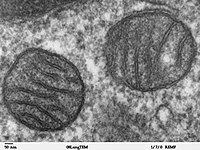
Photo from wikipedia
As an intracellular degradation system, autophagy is an essential and defensive cellular program required for cell survival and cellular metabolic homeostasis in response to various stresses, such as nutrient deprivation… Click to show full abstract
As an intracellular degradation system, autophagy is an essential and defensive cellular program required for cell survival and cellular metabolic homeostasis in response to various stresses, such as nutrient deprivation and the accumulation of damaged organelles. In general, autophagy flux consists of four steps: (1) initiation (formation of phagophore), (2) maturation and completion of autophagosome, (3) fusion of autophagosomes with lysosomes (formation of autolysosome), and (4) degradation of intravesicular components within autolysosomes. The number of genes and reagents that modulate autophagy is increasing. Investigation of their effect on autophagy flux is critical to understanding the roles of autophagy in many physiological and pathological processes. In this review, we summarize and discuss ways to analyze autophagy flux quantitatively and qualitatively with the use of imaging tools. The suggested imaging method can help estimate whether each modulator is an inhibitor or a promoter of autophagy and elucidate the mode of action of specific genes and reagents on autophagy processes.
Journal Title: BMB Reports
Year Published: 2020
Link to full text (if available)
Share on Social Media: Sign Up to like & get
recommendations!